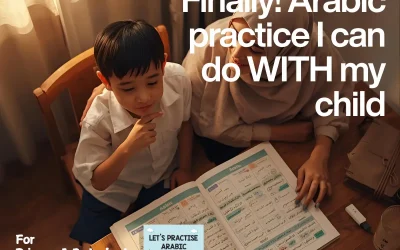Hey there, wonderful parents of primary Madrasah students in Singapore! Are you ready to begin an exciting journey of transforming your home into an exciting Arabic learning environment? Let’s explore how to create an Arabic learning environment at home that will bring joy and benefit to our Madrasah students. We’ll dive into some fun and practical ways to develop an Arabic oasis right in your living room. Trust me, your little language learners will be picking up Arabic faster than you can say, “Marhaban!”
Why Create an Arabic Learning Environment at Home?
Before jumping into our strategies, let’s discuss why this is so important. As parents in Singapore, we play a crucial role in our Madrasah students’ language learning journey. We know that our children get less exposure to Arabic than they would in an Arabic-speaking country. That’s why home Arabic practice is so crucial. But don’t worry! By creating an Arabic-rich environment at home, we can give our children the extra boost they need to excel in their studies and beyond.
Research shows that immersive language environments significantly improve language acquisition, especially for young learners (Krashen, 20031). So, by bringing Arabic into your daily home life, you’re setting your child up for success!
7 Fun Strategies to Create Your Arabic Oasis
These strategies are not just about learning but about having fun while boosting home Arabic practice for Singapore Madrasah students. Let’s dive in and make Arabic learning an exciting part of our daily lives!
1. Transform Your Home into an Arabic Label Factory
First up, let’s play a game of “Label Everything!” Grab some sticky notes or cute labels and go wild! Label everyday items around your house in Arabic. From “باب” (door) to “ثلاجة” (refrigerator), turn your home into a living, breathing Arabic dictionary.

Pro tip: Make it a family activity! Get your kids involved in writing and placing the labels. It’s a sneaky way to practice Arabic writing while having fun!
2. Set Up an Arabic Reading Nook
Create a cozy corner dedicated to Arabic reading. Fill it with colorful Arabic storybooks, magazines, and, of course, your trusty “Let’s Practice Arabic – Level 1” workbook. Add some comfy cushions, and voila! You’ve got an inviting space that screams, “Come read Arabic with me!”
Remember, the key is to make it appealing. The more inviting the space, the more likely your child will gravitate towards it for some Arabic reading time.
3. Bring Arabic to Movie Night
Who says screen time can’t be educational? Dedicate one family movie night a week to watching Arabic cartoons or films with English subtitles. It’s a fun way to expose your child to native Arabic speakers and colloquial expressions.

Pro tip: Start with short, simple cartoons and gradually move to more complex content as your child’s comprehension improves. Studies have shown that tools like subtitles can enhance comprehension and vocabulary acquisition in language learners (Al-Mamun & Rahman, 20172).
4. Create an Arabic Music Playlist
Music is a powerful tool for language learning. Create a playlist of catchy Arabic songs and play them during car rides, while doing chores, or just for fun dance parties! You’ll be amazed at how quickly your child picks up new vocabulary through music.
5. Design an Arabic Game Corner
Who says learning can’t be play? Set up a dedicated space for Arabic board games, puzzles, and flashcards. Include games that focus on Arabic vocabulary, grammar, and conversation skills. Don’t forget to add your “Let’s Practice Arabic – Level 1” workbook to this corner for some structured practice time!
6. Establish an “Arabic Hour” Each Day
Designate a specific time each day as “Arabic Hour.” During this time, encourage everyone in the family to speak only in Arabic. Yes, it might feel awkward initially, but stick with it! Use this time to practice conversations, play Arabic games, or work on exercises from your “Let’s Practice Arabic – Level 1” workbook.
Research has shown that consistent, daily exposure to a foreign language significantly improves learning outcomes, especially for young learners (Muñoz, 20063). This makes your daily ‘Arabic Hour’ a powerful tool in your child’s language learning journey.
Remember, consistency is key. Even if it’s just for 30 minutes a day, regular practice will make a big difference in your child’s Arabic skills.
7. Create a “Word of the Day” Ritual
Start each day by introducing a new Arabic word or phrase. Write it on a small whiteboard or chalkboard in a prominent place, like the kitchen. Encourage everyone to use the word throughout the day in different contexts.

Pro tip: Make it a challenge! See who can use the word of the day most in conversation. A little friendly competition can be a great motivator!
Bringing It All Together
Creating an Arabic oasis at home can be manageable. Start with one or two strategies and gradually incorporate more as you and your child get comfortable. Remember, the goal is to make Arabic a natural, fun part of your daily life.
Your “Let’s Practice Arabic – Level 1” workbook is an excellent resource to complement these immersive strategies. Use it during your Arabic Hour, in your reading nook, or as part of your game time to reinforce the language skills your child is picking up through these fun activities.
By implementing these Arabic immersion tips, Singapore families can significantly enhance their children’s language learning experience. You’re giving your child a tremendous advantage in their language-learning journey. So, dear parents, are you ready to transform your home into an Arabic oasis? Your little language learners are going to thrive!
Remember, learning a language is a journey, not a destination. Enjoy the process, celebrate small victories, and watch your child’s Arabic skills blossom in your very own home oasis. Happy Arabic learning, everyone!
References:
- Krashen, S. D. (2003). Explorations in Language Acquisition and Use. Portsmouth, NH: Heinemann. ↩︎
- Al-Mamun, A., & Rahman, A. R. M. M. (2017). Using Google Translate in EFL Classrooms: Boon or Bane? Journal of ELT Research, 2(2), 69-85. ↩︎
- Muñoz, C. (Ed.). (2006). Age and the rate of foreign language learning (Vol. 19). Multilingual Matters. ↩︎





